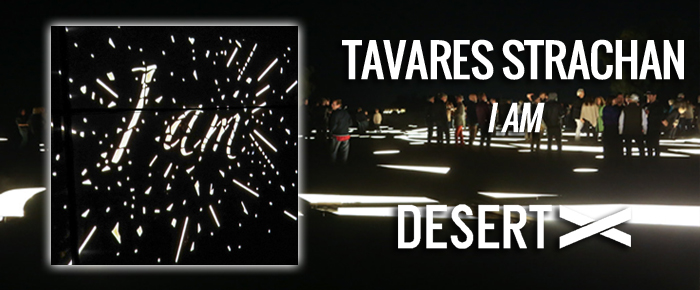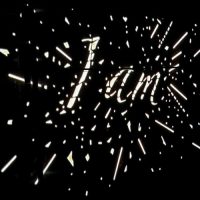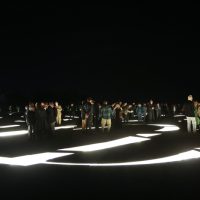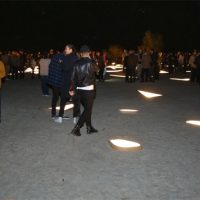
By Angela Romeo
Tavares Strachan created the Desert X installation I am. Using the tenets of Vedic Philosophy mixed with the Theory of Relativity, he created the work as a means to explore the relationship between humans and their environment. He pushes the notions of exploration, displacement, possibilities and improbabilities.
How does Vedic Philosophy and Einstein’s’ Theory of Relativity combine in I am? Vedic teaching seeks to provide answers to all unanswered questions. It is the quest for the ultimate truth. Einstein found that space and time were interwoven into a single continuum and that events that occur at the same time for one observer could occur at different times for another. There is no “absolute” frame of reference. Every experience in time, it’s always in relation to something else. The ultimate truth is relative to the individual.
Is there an ultimate answer to the question I am? Or it there no answer? To Tavares these ideas open themselves to other ideas.
Tavares and a team of local workers dug 218 holes over a 98,000 square foot area, roughly the size of two football fields. Solar powered neon tubes surround the craters’ perimeter. From the ground the viewer interacts with a glowing abstract crevasse. But viewed from above the words I am come into focus.
The piece plays with perception that creates disorientation. From the ground the viewer is engaged in an abstraction. The concept of relativity unknowingly comes into play. Time is not linear and nothing is fixed. From the night sky I am is the dominant feature. Same place. Same time. Different experiences. Different truths?
I am requires the viewer to be in the moment. To some the work is “pretty’ which is a subjective but legitimate means of processing the work. To others the work has more jarring undertones – I am questions the core of one’s existence. One has to pay attention to the environment, the area, to process the work. We create a separation within the work – separation from the landscape and each other. I am reminds the viewers of the importance to connect to the landscape and to deconstruct what preconceived notions we have of our own existence. I am, is a sincere effort to connect to us to the landscape and to each other.
Tavares is a student of social anthropology. He observes what the landscape offers – from the physical features to the people who inhabit that space. His observations manifest in his works. His seminal Seen/Unseen (2011) included over 50 pieces that explored themes of presence and absence. Seen/Unseen was a type of “meditative experience” with physical access restricted to the organizers. The public’s only access was via a website and an illustrated catalogue.
I am seems to embrace the definition of diversity as an active idea. There is a need for people to mix together. The ‘I’ in I am is it me or is it the audience? That question can be a bridge to opening the communication between people and to discover what diversity may be, could be or fails to be.
Tavares noted that “I am creates a monologue that becomes a dialogue. Art is an extension of the individual and the environment especially when one is invested in changing the current conditions. The piece in not a judgment or an assessment. It is simply a question.”
“The Richard Prince piece, Third Place, speaks to the same question, I am? That piece may be more jarring but I am is no less provocative. We need to question who we are and why we are here. We need to understand the same experience, may be a shared experience but is it an individual experience.”
Is that the key to understanding diversity? I am. Or I am?
Tavares begins the search.
Vedic philosophy holds “Bright but hidden, the Self dwells in the heart.”
(Photos by Lani Garfield)












































